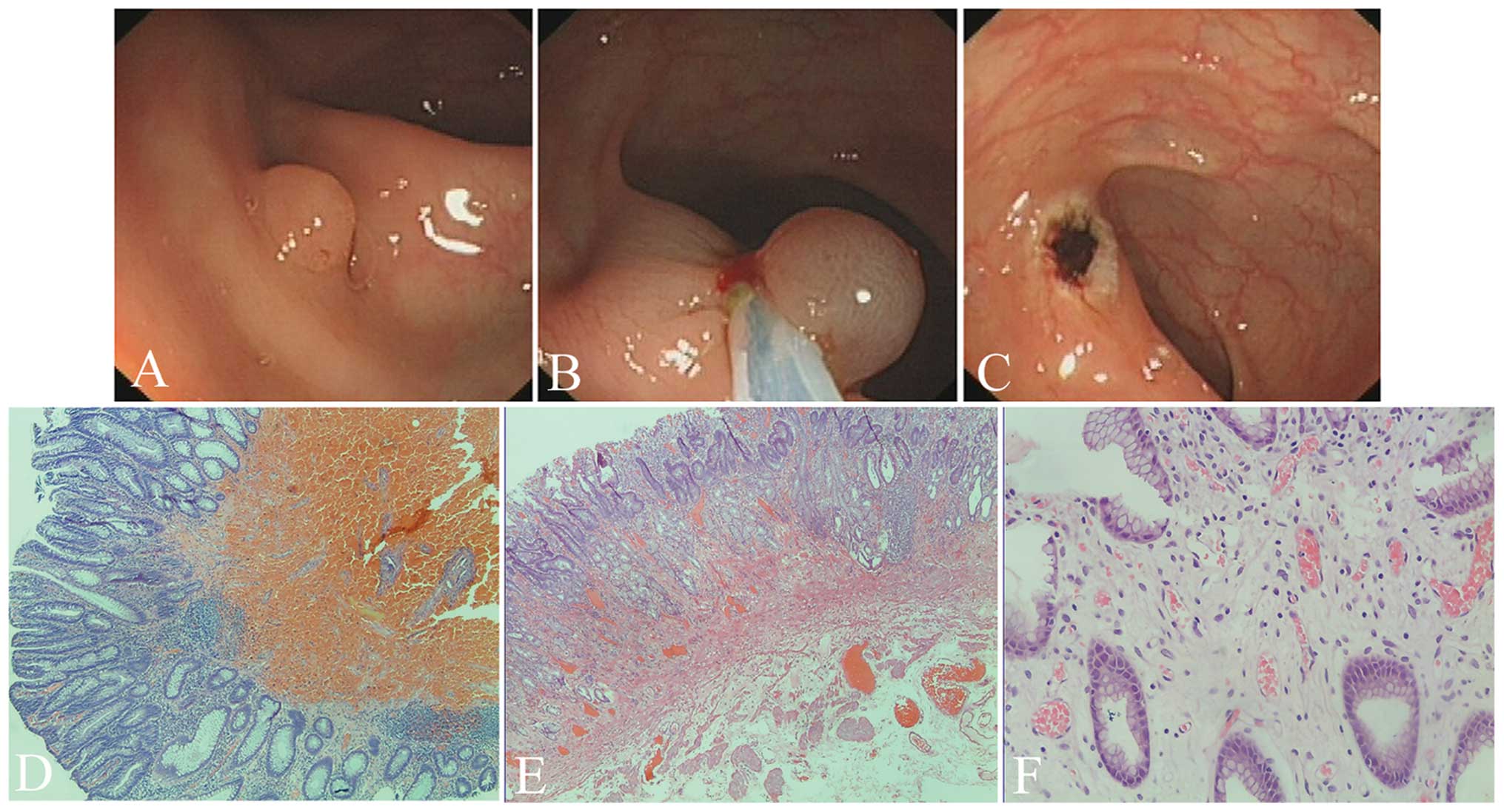|
1.
|
Rösch T, Sarbia M, Schumacher B, et al:
Attempted endoscopic en bloc resection of mucosal and submucosal
tumors using insulated-tip knives: a pilot series. Endoscopy.
36:788–801. 2004.PubMed/NCBI
|
|
2.
|
Inoue H, Minami H, Kobayashi Y, et al:
Peroral endoscopic myotomy (POEM) for esophageal achalasia.
Endoscopy. 42:265–271. 2010. View Article : Google Scholar
|
|
3.
|
Bures J, Kopácová M, Kvetina J, et al:
Different solutions used for submucosal injection influenced early
healing of gastric endoscopic mucosal resection in a preclinical
study in experimental pigs. Surg Endosc. 23:2094–2101. 2009.
View Article : Google Scholar
|
|
4.
|
Goto O, Fujishiro M, Kodashima S, et al:
Short-term healing process of artificial ulcers after gastric
endoscopic submucosal dissection. Gut Liver. 5:293–297. 2011.
View Article : Google Scholar : PubMed/NCBI
|
|
5.
|
Fujishiro M, Yahagi N, Kashimura K, et al:
Comparison of various submucosal injection solutions for
maintaining mucosal elevation during endoscopic mucosal resection.
Endoscopy. 36:579–583. 2004. View Article : Google Scholar
|
|
6.
|
Eun SH, Cho JY, Jung IS, et al:
Effectiveness of sodium alginate as a submucosal injection material
for endoscopic mucosal resection in animal. Gut Liver. 1:27–32.
2007. View Article : Google Scholar : PubMed/NCBI
|
|
7.
|
Uraoka T, Fujii T, Saito Y, et al:
Effectiveness of glycerol as a submucosal injection for EMR.
Gastrointest Endosc. 61:736–740. 2005. View Article : Google Scholar : PubMed/NCBI
|
|
8.
|
Polymeros D, Kotsalidis G, Triantafyllou
K, Karamanolis G, Panagiotides JG and Ladas SD: Comparative
performance of novel solutions for submucosal injection in porcine
stomachs: An ex vivo study. Dig Liver Dis. 42:226–229. 2010.
View Article : Google Scholar : PubMed/NCBI
|
|
9.
|
Hirao M, Masuda K, Asanuma T, et al:
Endoscopic resection of early gastric cancer and other tumors with
local injection of hypertonic saline-epinephrine. Gastrointest
Endosc. 34:264–269. 1988. View Article : Google Scholar : PubMed/NCBI
|
|
10.
|
Yamamoto H, Yube T, Isoda N, et al: A
novel method of endoscopic mucosal resection using sodium
hyaluronate. Gastrointest Endosc. 50:251–256. 1999. View Article : Google Scholar : PubMed/NCBI
|
|
11.
|
Feitoza AB, Gostout CJ, Burgart LJ,
Burkert A, Herman LJ and Rajan E: Hydroxypropyl methylcellulose: A
better submucosal fluid cushion for endoscopic mucosal resection.
Gastrointest Endosc. 57:41–47. 2003. View Article : Google Scholar : PubMed/NCBI
|
|
12.
|
Akagi T, Yasuda K, Tajima M, et al: Sodium
alginate as an ideal submucosal injection material for endoscopic
submucosal resection: preliminary experimental and clinical study.
Gastrointest Endosc. 74:1026–1032. 2011. View Article : Google Scholar
|
|
13.
|
Giday SA, Magno P, Buscaglia JM, et al: Is
blood the ideal submucosal cushioning agent? A comparative study in
a porcine model. Endoscopy. 38:1230–1234. 2006. View Article : Google Scholar : PubMed/NCBI
|
|
14.
|
Matsui Y, Inomata M, Izumi K, Sonoda K,
Shiraishi N and Kitano S: Hyaluronic acid stimulates tumor-cell
proliferation at wound sites. Gastrointest Endosc. 60:539–543.
2004. View Article : Google Scholar : PubMed/NCBI
|
|
15.
|
Tan B, Wang JH, Wu QD, Kirwan WO and
Redmond HP: Sodium hyaluronate enhances colorectal tumour cell
metastatic potential in vitro and in vivo. Br J Surg. 88:246–250.
2001. View Article : Google Scholar
|
|
16.
|
Obara S, Muto H, Shigeno H, et al: A
three-month repeated oral administration study of a low viscosity
grade of hydroxypropyl methylcellulose in rats. J Toxicol Sci.
24:33–43. 1999. View Article : Google Scholar : PubMed/NCBI
|
|
17.
|
Shastri YM, Kriener S, Caspary WF and
Schneider A: Autologous blood as a submucosal fluid cushion for
endoscopic mucosal therapies: results of an ex vivo study. Scand J
Gastroenterol. 42:1369–1375. 2007. View Article : Google Scholar : PubMed/NCBI
|
|
18.
|
Sato T: A novel method of endoscopic
mucosal resection assisted by submucosal injection of autologous
blood (blood patch EMR). Dis Colon Rectum. 49:1636–1641. 2006.
View Article : Google Scholar : PubMed/NCBI
|
|
19.
|
Tajika M, Niwa Y, Bhatia V, et al:
Comparison of endoscopic submucosal dissection and endoscopic
mucosal resection for large colorectal tumors. Eur J Gastroenterol
Hepatol. 23:1042–1049. 2011.PubMed/NCBI
|
|
20.
|
Rosenberg N: Submucosal saline wheal as
safety factor in fulguration or rectal and sigmoidal polypi. AMA
Arch Surg. 70:120–122. 1955. View Article : Google Scholar : PubMed/NCBI
|
|
21.
|
Uraoka T, Kawahara Y, Ohara N, Kato J,
Hori K, Okada H and Yamamoto K: Carbon dioxide submucosal injection
cushion: an innovative technique in endoscopic submucosal
dissection. Dig Endosc. 23:5–9. 2011. View Article : Google Scholar : PubMed/NCBI
|
|
22.
|
Arantes V, Albuquerque W, Benfica E, et
al: Submucosal injection of 0.4% hydroxypropyl methylcellulose
facilitates endoscopic mucosal resection of early gastrointestinal
tumors. J Clin Gastroenterol. 44:615–619. 2010.
|
|
23.
|
Fujishiro M, Yahagi N, Kashimura K, et al:
Tissue damage of different submucosal injection solutions for EMR.
Gastrointest Endosc. 62:933–942. 2005. View Article : Google Scholar : PubMed/NCBI
|
|
24.
|
Shi Q, Zhong YS, Yao LQ, Zhou PH, Xu MD
and Wang P: Endoscopic submucosal dissection for treatment of
esophageal submucosal tumors originating from the muscularis
propria layer. Gastrointest Endosc. 74:1194–1200. 2011. View Article : Google Scholar : PubMed/NCBI
|
|
25.
|
Xu MD, Cai MY, Zhou PH, et al: Submucosal
tunneling endoscopic resection: a new technique for treating upper
GI submucosal tumors originating from the muscularis propria layer.
Gastrointest Endosc. 75:195–199. 2012. View Article : Google Scholar : PubMed/NCBI
|
|
26.
|
Sumiyama K, Gostout CJ, Rajan E, Bakken
TA, Knipschield MA and Marler RJ: Submucosal endoscopy with mucosal
flap safety valve. Gastrointest Endosc. 65:688–694. 2007.
View Article : Google Scholar : PubMed/NCBI
|
|
27.
|
Khashab MA and Kalloo AN: NOTES: Current
status and new horizons. Gastroenterology. 142:704–710. 2012.
View Article : Google Scholar : PubMed/NCBI
|












